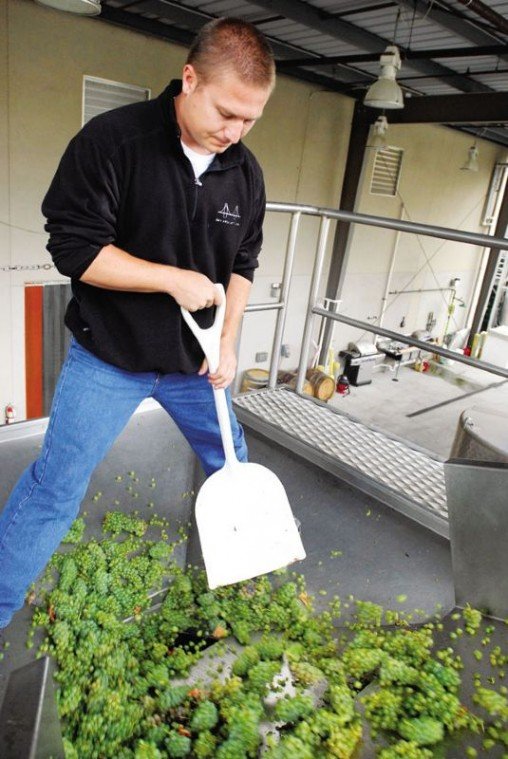Amid concerns of a moth quarantine in South County, Gilroy
winemakers say a late harvest due to a uncharacteristically cool
summer is turning out to be a blessing in disguise.
Amid concerns of a moth quarantine in South County, Gilroy winemakers say a late harvest due to a uncharacteristically cool summer is turning out to be a blessing in disguise.
The mild weather produces a long, slow ripening and enhances the taste of the grapes – a rarity in these parts.
“I’ve been here 10 years and I haven’t seen something like this,” said Mike Vanni of Solis Winery on Hecker Pass Road. “We are going to be sampling again this week and hoping to start picking next week. Some vineyards have been picking but we don’t want to be overanxious.”
In South County – which includes Gilroy wineries such as Clos La Chance, Fortino, Thomas Kruse, Kirigin Cellars, Sarah’s Vineyard, Sycamore Creek and Fernwood Cellars among others – grapes are the eighth top-selling crop.
Wine production in Santa Clara County in 2009 was worth $6.98 million, according to the Santa Clara Division of Agriculture. More than 5,600 tons were produced that year with about three to five tons produced for every acre.
For the 2010 crop, winemakers are finding they have to hold themselves back through the next couple of weeks while the grapes ripen as opposed to previous years where grapes are usually harvested by early September.
Vanni hasn’t tested the grapes after this weekend’s heat wave, but expects the grape varieties such as sauvignon blanc, that normally harvest earlier in the season are now pushing the adequate levels of ripeness.
The ripening of the grapes has been inconsistent this year, and Vanni said he has had to let go 15 percent of the estate’s overall crop. He said that’s fine as he strives for quality, not quantity.
“The color of the red grapes is really dark this year, so I think the wine quality could be superb,” he said.
Dropping the grapes can help speed up the ripening process and intensify the flavor of the grape, said Vanni. “By having less fruit, you’re getting more intensity because all the ripening energy of the plant goes into fewer berries,” he said. “We don’t shoot for high volume. Our goal is to have a balanced plant.
Dan Martin who owns Therese Vineyards and Martin Ranch Winery at Redwood Retreat Road together with his wife Therese, has had to drop 25 percent of his crop due to the cool spell.
“Every time we get late, we get nervous,” he said.
The couple has been operating the vineyard since 1993, and said weather in the past couple of years has been far less accommodating to grapes.
“There have been problems in this area in the past,” he said. “Last year we had rain on October 13 –11 inches in one day – and that caused a lot of problems.
“In 2008 we lost a lot of crop due to slow frost. This could be a wonderful year. It could be one of the best years we’ve had for a while.”
The winemaker will usually decide to harvest the grapes on the level of sugar or the Brix, which is measured in degrees.
Most wineries start collecting them at 24 or 25 degrees. The acidity and the pH levels of the grapes are also tested, and the most attentive growers will also sample color and taste and follow weather forecasts religiously, Martin said.
Grapes in harvest season usually increase one Brix degree a week. When temperatures push 90 degrees or more, the sugar may rise half a degree more, Martin said. To ensure the sun shines directly on the grapes and transmits the adequate heat, Martin said his growers are removing the greenery from the cluster.
“For grape growing, it’s more about the climate than the soil,” Martin said. “There must be enough heat to ripen the grapes but the nighttime temperatures need to be cold, below 60 degrees.”
His vineyards are at a 600-feet elevation and enjoy the coolness coming from the coast.
Though Martin is enthusiastic about the slow-ripening process brought by the cool temperatures enhancing the quality of the grapes, he is worried it will give animals more time to steal the berries.
“Around 18 Brix, every animal out there is interested,” he said. “All the foxes, and turkeys. The deer is probably the most worrisome predator, but if you fence your property, they are no longer a problem.”
Flash tapes, scarecrows and the works are already up scaring off the birds, and the harvest forecast for Therese Vineyards and Martin Ranch Winery will be a smooth one, Martin said.
When the grapes are finally ready to pick, Vanni expects they’ll all be coming down at once and pressed the same day. This means Vanni will have another issue to contend with: space.
“By the beginning or middle of October, we should be buried with fruit,” he said.















